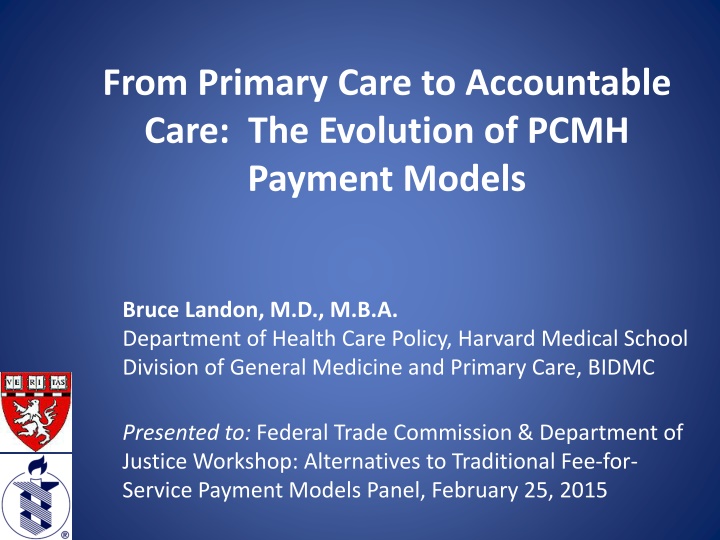
Evolution of PCMHC Payment Models
Explore the evolution of payment models for Patient-Centered Medical Homes (PCMHC) from primary care to accountable care, highlighting the importance of creating policies and incentives for a high-functioning primary care system. Discover the diverse payment structures, initiatives, and operational tools shaping the future of healthcare delivery.
Download Presentation

Please find below an Image/Link to download the presentation.
The content on the website is provided AS IS for your information and personal use only. It may not be sold, licensed, or shared on other websites without obtaining consent from the author. If you encounter any issues during the download, it is possible that the publisher has removed the file from their server.
You are allowed to download the files provided on this website for personal or commercial use, subject to the condition that they are used lawfully. All files are the property of their respective owners.
The content on the website is provided AS IS for your information and personal use only. It may not be sold, licensed, or shared on other websites without obtaining consent from the author.
E N D
Presentation Transcript
From Primary Care to Accountable Care: The Evolution of PCMH Payment Models Bruce Landon, M.D., M.B.A. Department of Health Care Policy, Harvard Medical School Division of General Medicine and Primary Care, BIDMC Presented to: Federal Trade Commission & Department of Justice Workshop: Alternatives to Traditional Fee-for- Service Payment Models Panel, February 25, 2015
Foundational Principles of the PCMH The current primary care system is dysfunctional Primary care (in some form) is good For patients For the health system overall Need to put in place policies and incentives to achieve a high functioning primary care system
PCMH Initiatives Organized by health plans, state, purchasers, or other groups Seek to use alternative primary care payment models to create an environment that supports the transformation of primary care practices to PCMHs Aided by: Learning collaboratives Practice coaches Data and feedback
PCMH Payments are Diverse 0% 10% 20% 30% 40% 50% 60% FFS only PMPM only + P4P FFS + PMPM FFS + PMPM + P4P Shared savings N=114 Source: Edwards, Bitton, Hong, Landon. Health Affairs. 2014.
PMPM Median of Mean PMPM (IQR) All Mean PMPM $5.00 (3.00-8.00) Small Commercial Single Payer Mean PMPM $4.00 (3.50-7.00) Large Commercial Single Payer Mean PMPM $5.00 (2.50-8.00) Multipayer Mean PMPM $7.25 (5.35-24.00) Medicaid Only Mean PMPM $5.00 (3.00-12.15) Notes: PMPM was collected as minimum and maximum. We used the midpoint as the mean PMPM. Excludes programs that only pay PMPM fees for patients with multiple chronic diseases.
Comparison of PCMH initiatives in 2009 and 2013 2009 (N=26) 2013 (N=114) Total patients Time limited initiatives (%) Median patients per initiative # Multi-payer initiatives Median patients in multi-payer Use shared savings (%) PMPM (range) Use Learning Collaborative and Consultants Performing Program Evaluation 4,971,070 62% 30,000 9 39,000 0% $0.50-$9.00 15% 40% 20,970,277 20% 40,986 22 146,636 44% $0.25-$60.00 36.8% 92% Source: Edwards, Bitton, Hong, Landon. Health Affairs. 2014.
Operational Tools of PCMHs Multidisciplinary teams Enhanced use of HIT and chronic disease registries for population health management Data to inform care management Online patient portals for proactive management of acute and chronic conditions Focus on care transitions and care coordination
From the Medical Home Hospital Sub-specialist and Ancillary Services Patient-Centered Medical Home Insurer Data Center
ACOs and the PCMH In order to succeed, most ACOs will need to build upon a solid primary care foundation Attributes of enhanced primary care are fully aligned with the goals of ACOs Yet, current ACO programs do not specifically change payment for primary care
Strategies for Integrating the PCMH into ACOs ACO contracts could include explicit support for enhanced primary care ACOs could invest in developing PCMH capabilities internally HIT investments Expanded PCP/urgent care access ACOs can change how physician performance is measured and compensated (e.g., based on size/complexity of panel, quality or utilization metrics, non-visit-based services)
Conclusions PCMH payment models are evolving over time Payments are larger, more divorced from typical FFS payment, and including incentives based on spending and utilization More integration of risk sharing and accountability similar to ACOs The PCMH will likely serve as the foundation of ACOs, but ACOs likely will need to incorporate reformed payments to support enhanced primary care
Thank you! landon@hcp.med.harvard.edu blandon@bidmc.harvard.edu


